Contents
1.3 Ritualistic worship of Sheshanag
1.4 Reason underlying the ritualistic worship of Sheshnag in Ananta vrat
1.5 Ritualistic worship of the thread symbolic of Ananta
1.6 The importance and science underlying the Ananta thread of 14 knots
1.7 Science underlying offering sweet puris made of pumpkin in Anantpujan
1.8 The teaching gained from Ananta Chaturdashi
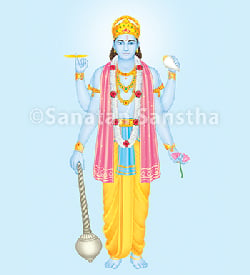
Ananta – Bhagawan Shri Vishnu
During the period, from Shri Ganesh Chaturthi (Bhadrapad Shukla Chaturthi) to Ananta Chaturdashi, Shri Ganesh energy emitted is in higher proportion. Similarly, on this day the Ganesh Principle emitted is also 10% more in the Universe.
1. Ananta Vrat
The implied meaning of Ananta is the Energy in the form of Chaitanya that has no end.
The duration of Ananta vrat is fourteen years. Thereafter the vrat is concluded. This vrat is undertaken on the advice of someone or getting the thread of Ananta easily.
1.1 Objective of Ananta vrat
Ananta vrat is observed with the intention of fulfillment of worldly desires (‘kamya vrat’). This vrat is mainly observed for regaining lost prosperity. On the day of Ananta Chaturdashi, the frequencies of Shri Vishnu are active in the Universe. It is easy for average people to attract and absorb these frequencies on this day. Doing Anantapujan means absorbing the action-energy of Shri Vishnu.
The presiding Deity of Ananta vrat is Ananta, that is, Bhagawan Shri Vishnu. The Deities Yamuna and Shesha also accompany Shri Vishnu.
1.2 Ananta vrat pujan
As far as possible, the ritualistic worship of Ananta should be performed by a couple. In exceptional cases, a man or a woman alone can perform the worship.
A) Before commencing the vrat pujan, the resolve to perform this pujan for regaining the lost prosperity is made.
B) Thereafter, in the Yamunapujan, Shri Yamuna Devi is worshipped ritualistically with sixteen substances.
C) First Shri Yamuna Devi is offered a seat.
D) The ritual of washing the Holy feet of Shri Yamuna Devi is done.
E) Thereafter, arghya is offered.
F) Thereafter, the ritual of giving a bath with five substances is performed.
G) The Devi is consecrated with water.
H) The lady doing the vrat offers turmeric powder and vermillion to Shri Yamuna Devi
I) Later unbroken rice grains are put in a kalasha and body-worship (anga-puja) of Shri Yamuna Devi is done.
J) The worship is concluded by offering substances like incense-cake (dhup), arati, Holy sacrament (naivedya) etc.
Subtle-process taking place on invoking Yamuna in the kalasha filled with water during the ritualistic worship of Ananta vrat
By invoking Yamuna, the frequencies of Shrikrushna in the water are awakened. These frequencies are obtained by the worshipper and they destroy the black, cylindrical, spiral-shaped raja-tama-dominant frequencies in the worshipper’s body. With this, the body of the worshipper is purified. The ritualistic worship done with a pure body gives more benefit.
1.3 Ritualistic worship of Sheshanag
In this the cobra (nag) with seven hoods made of the sprouts of a type of grass called darbha is ritualistically worshipped as a symbol of Sheshanag.
A) First the Deity Sheshanag is invoked.
B) The ritual of offering a seat to Sheshanag is performed. After this, the rituals like washing of Holy feet, offering of water etc. are performed.
C) The body-worship (anga-puja) of the Deity Sheshanag is done.
D) His seven hoods are worshipped.
E) Thereafer His Name-worship (nampuja) is done.
F) At the end, incense, lamp, Holy sacrament etc. are offered.
1.4 Reason underlying the ritualistic worship of Sheshnag in Ananta vrat
On the day of Ananta Chaturdashi, action frequencies associated with Shri Vishnu principle are emitted in the Universe. Deity Sheshnag is an excellent carrier of these frequencies.
The task of Energy of Action (Kriyashakti) associated with human body
The action energy present in human body maintains his gross body through the medium of the Absolute Earth Principle and the shape of the body through the medium of the Absolute Water Principle. Deity Shesha provides energy required for the various tasks of that part of the Divine Consciousness that governs the functioning of the mind and body (Chetanashakti).
The action frequencies in the form of the Absolute Fire Principle present in the darbha circulate in active form. Through the symbol of Sheshanag made of darbha, the round spiral action frequencies of Shri Vishnu present in the Universe are attracted. These frequencies spread at the place of ritualistic worship. They touch the worshipper and spread in his body.
1.5 Ritualistic worship of the thread symbolic of Ananta
After the ritualistic worship of Sheshanag, the worship of the thread, the symbol of Shri Vishnu, that is, Ananta is done. Before worshipping the thread is purified by reciting mantras. For the consecration of Ananta, Madanant Deity, that is, Bhagawan Shri Vishnu is invoked. Among the two threads in the glass (fulpatra), the thread on the left of the worshiper is the male thread and thread to his right is the female thread.
A) After the consecration of the thread, to offer seat to Ananta. Unbroken rice grains smeared with vermillion (akshata) are offered from below upwards on the 14 knots on the male thread. Thereafter, akshata are offered on the female thread in a similar way.
B) Gandhodak snan – Bathing the Deity with water mixed with sandalwood paste (gandh).
C) Pushpodak snan – Bathing the Deity with water containing flowers.
D) Phalodak snan – Bathing the Deity with fruit juice.
E) Thereafter the deity is bathed with water containing precious stones.
F) Then the threads are placed for ritualistic worship.
G) The threads are ritualistically worshiped with five substances (panchopachar) using substances like gandh, flower etc.
H) Thereafter dwadash avaran ritualistic worship is performed. Thereafter, leaves like Bel, Karavir, Shami, Tulasi, Apamarg, Datura and Tadini are offered and patrapuja is performed. After Anantapujan, the special naivedya of sweet puris made of pumpkin is offered. The threads placed in the glass are taken out and tied on the arm and the old threads are discarded.
1.6 The importance and science underlying the Ananta thread of 14 knots
There are 14 main knots (granthis) in human body. These knots are connected to each other through the flow of Chetanashakti. As a symbol of which, the thread with 14 knots is ritualistically worshipped with recitation of mantras.
The action frequencies of Shri Vishnu present in the Universe are attracted towards the Ananta threads, after its ritualistic worship and the thread is charged with these frequencies. By tying the thread on the arms, the entire body of the person is charged with these energy frequencies. Thus, the flow of Chetanashakti present in his body gains momentum.
1.7 Science underlying offering sweet puris made of pumpkin in Anantpujan
Naivedya of sweet puris made of pumpkin is offered in Anantpujan and the Deity of vrat is immersed. The vrat is concluded (udyapan) after 14 years.
Subtle air sheaths of pumpkin have the capacity of attracting and storing the action energy frequencies of the Universe. Hence, the active frequencies of Energy of Action are attracted in the puris made of pumpkin in a short time.
Sanatan Hindu Dharma includes observation of particular vrats on particular tithis, various actions associated with that vrat, observation of rituals and restrictions etc. In Hindu Dharma, rules are laid down in the Scriptures for enabling the humans to be strong, competent and to gain all necessary energies.

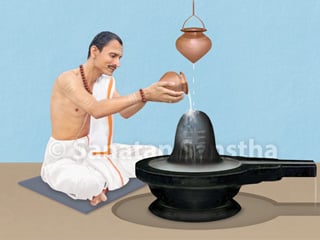 Mahashivratri 2024
Mahashivratri 2024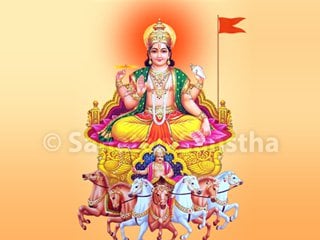 Ratha Saptami 2024
Ratha Saptami 2024 Maghi Shri Ganesh Jayanti 2024
Maghi Shri Ganesh Jayanti 2024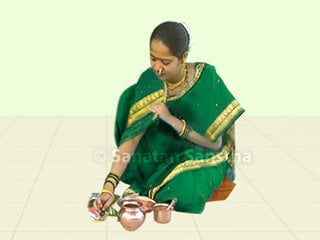 Importance of Adhik maas (Purushottam maas)
Importance of Adhik maas (Purushottam maas)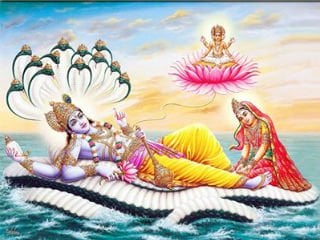 Vaikunth chaturdashi is an invaluable opportunity granted to us to worship Deity Shri Vishnu
Vaikunth chaturdashi is an invaluable opportunity granted to us to worship Deity Shri Vishnu How to celebrate Navaratri in adverse times caused by coronavirus pandemic ?
How to celebrate Navaratri in adverse times caused by coronavirus pandemic ?
How to discard the Old Ananta Threads? Has to be discarded in a flowing river?
Cut them into pices and buried?
Please explain.
Thank you.
Namaskar,
It is mentioned in the Anant Chaturdashi vrat puja that, the Ananta threads should be donated to the Brahmin.
Some say we can remove thread after 14 days tying. Can it be visarjit in lake after 14 days or is it necessary to keep it at home for 1 year till next puja.
Namaskar,
There are different traditions related to the Ananta’s thread.
– Some wear it on the arm and remove it directly after one year. Give the old thread to the purohit (priest) and wear the new one.
– Some wear it on the arm and remove it after 14 days and keep it in the home temple, donate it after one year, and wear a new one.
If you ask local purohit (priests) then you will be able to understand the traditions and customs that prevail in your area.